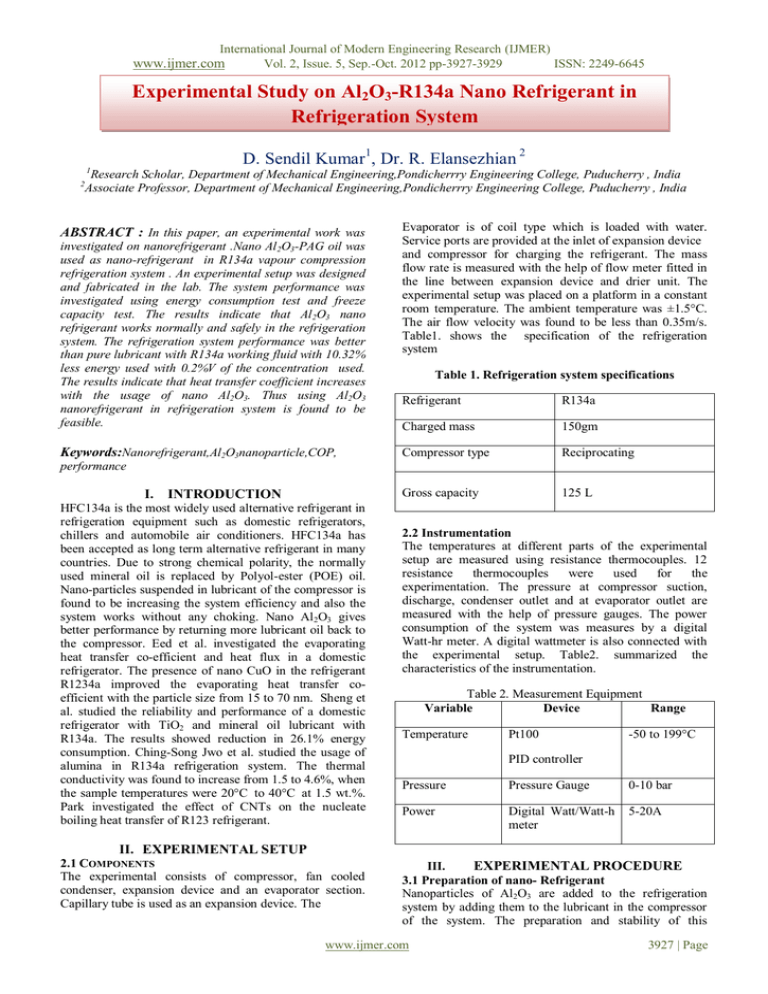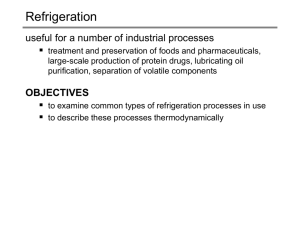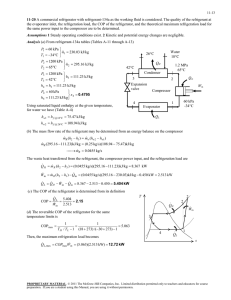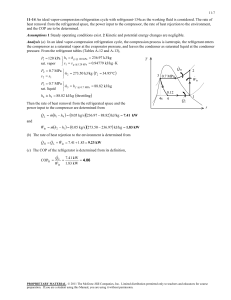Experimental Study on Al2O3-R134a Nano Refrigerant
advertisement

International Journal of Modern Engineering Research (IJMER) Vol. 2, Issue. 5, Sep.-Oct. 2012 pp-3927-3929 ISSN: 2249-6645 www.ijmer.com Experimental Study on Al2O3-R134a Nano Refrigerant in Refrigeration System D. Sendil Kumar1, Dr. R. Elansezhian 2 1 2 Research Scholar, Department of Mechanical Engineering,Pondicherrry Engineering College, Puducherry , India Associate Professor, Department of Mechanical Engineering,Pondicherrry Engineering College, Puducherry , India ABSTRACT : In this paper, an experimental work was investigated on nanorefrigerant .Nano Al 2O3-PAG oil was used as nano-refrigerant in R134a vapour compression refrigeration system . An experimental setup was designed and fabricated in the lab. The system performance was investigated using energy consumption test and freeze capacity test. The results indicate that Al 2O3 nano refrigerant works normally and safely in the refrigeration system. The refrigeration system performance was better than pure lubricant with R134a working fluid with 10.32% less energy used with 0.2%V of the concentration used. The results indicate that heat transfer coefficient increases with the usage of nano Al2O3. Thus using Al2O3 nanorefrigerant in refrigeration system is found to be feasible. Keywords:Nanorefrigerant,Al2O3nanoparticle,COP, Evaporator is of coil type which is loaded with water. Service ports are provided at the inlet of expansion device and compressor for charging the refrigerant. The mass flow rate is measured with the help of flow meter fitted in the line between expansion device and drier unit. The experimental setup was placed on a platform in a constant room temperature. The ambient temperature was ±1.5°C. The air flow velocity was found to be less than 0.35m/s. Table1. shows the specification of the refrigeration system Table 1. Refrigeration system specifications Refrigerant R134a Charged mass 150gm Compressor type Reciprocating Gross capacity 125 L performance I. INTRODUCTION HFC134a is the most widely used alternative refrigerant in refrigeration equipment such as domestic refrigerators, chillers and automobile air conditioners. HFC134a has been accepted as long term alternative refrigerant in many countries. Due to strong chemical polarity, the normally used mineral oil is replaced by Polyol-ester (POE) oil. Nano-particles suspended in lubricant of the compressor is found to be increasing the system efficiency and also the system works without any choking. Nano Al 2O3 gives better performance by returning more lubricant oil back to the compressor. Eed et al. investigated the evaporating heat transfer co-efficient and heat flux in a domestic refrigerator. The presence of nano CuO in the refrigerant R1234a improved the evaporating heat transfer coefficient with the particle size from 15 to 70 nm. Sheng et al. studied the reliability and performance of a domestic refrigerator with TiO2 and mineral oil lubricant with R134a. The results showed reduction in 26.1% energy consumption. Ching-Song Jwo et al. studied the usage of alumina in R134a refrigeration system. The thermal conductivity was found to increase from 1.5 to 4.6%, when the sample temperatures were 20°C to 40°C at 1.5 wt.%. Park investigated the effect of CNTs on the nucleate boiling heat transfer of R123 refrigerant. 2.2 Instrumentation The temperatures at different parts of the experimental setup are measured using resistance thermocouples. 12 resistance thermocouples were used for the experimentation. The pressure at compressor suction, discharge, condenser outlet and at evaporator outlet are measured with the help of pressure gauges. The power consumption of the system was measures by a digital Watt-hr meter. A digital wattmeter is also connected with the experimental setup. Table2. summarized the characteristics of the instrumentation. Table 2. Measurement Equipment Variable Device Range Temperature Pt100 -50 to 199°C PID controller Pressure Pressure Gauge 0-10 bar Power Digital Watt/Watt-h meter 5-20A II. EXPERIMENTAL SETUP 2.1 COMPONENTS The experimental consists of compressor, fan cooled condenser, expansion device and an evaporator section. Capillary tube is used as an expansion device. The III. EXPERIMENTAL PROCEDURE 3.1 Preparation of nano- Refrigerant Nanoparticles of Al2O3 are added to the refrigeration system by adding them to the lubricant in the compressor of the system. The preparation and stability of this www.ijmer.com 3927 | Page International Journal of Modern Engineering Research (IJMER) Vol. 2, Issue. 5, Sep.-Oct. 2012 pp-3927-3929 ISSN: 2249-6645 www.ijmer.com lubricant and nanoparticle mixture is very important. The lubricant oil, a type commonly used in refrigeration and air-conditioning systems was poly alkylene glycol (PAG). This oil is selected owing to its common usage and superior quality. The nanoparticles of Al2O3 in the range 40-50 nm were mixed with PAG to synthesize nanolubricant in a recommended method for nanofluid. PAG oil was used as supplied by supplied without further purification. The nano particles of Al2O3 and PAG mixture was prepared with the aid of magnetic stirrer for 2 hrs. The mixture is then further kept vibrated with an ultrasonic homogenizer for half an hour to fully separate the nanoparticles and to prevent any clustering of particles in the mixture to obtain proper homogenization. No surfactant is added in this work as there may be any influence in reduction of thermal conductivity and performance. Figure 1. Variation of COP with capillary tube length 3.2 Nano- Refrigerant Concentration Nano-Refrigerant with 0.2% concentration of Al2O3 in the refrigerant R134a is prepared and tested in the setup. 3.3 Charging of the set up The fabricated experimental setup was filled with N2 gas at a pressure of 5 bar to 7 bar and this pressure is maintained for 45 minutes. Thus the system was ensured for no leakages. The system was evacuated by removing N2 gas. A vacuum pump was connected to the port provided in the compressor and the system was completely evacuated for the removal of any impurities. This process was carried out for all the trials. Through the service ports nano refrigerant was carefully added to the system. Precision electronic balance with accuracy ±1% was used to charge a mass of 150 gm. into the system. Every time the system was allowed to stabilize for 15 min. Figure2. Variation of Discharge pressure with time IV. Performance Test A performance test is made for 150 gm. of pure R134a system which is treated as the basis for comparison with other results. Nano Al2O3 –R134a with 0.2% concentration was fed to the experimental setup and the tests were conducted under the same conditions. In order to obtain repeatability each test was run for 3 to 4 times. Performance tests was also conducted with charge mass of the order of 150gm., 180 gm. and 200gm. Figure 3. Variation of Suction pressure with time V. CONCLUSION Addition of Nano Al2O3 in to the refrigerant shows improvement in the COP of the refrigeration system. Usage for Nano refrigerant reduces the length of capillary tube and cost effective. The following are the important results of the experimental investigation. 1. 4.1 Factors affecting Refrigeration System The important factors affect the performance of refrigeration system are Refrigeration effect, Coefficient of Performance (COP) and Energy factor(EF). 2. 3. a) Refrigeration effect q= Heat removal / mass flow rate or refrigerant (1) b) Coefficient of Performance COP = Heat Removal / Work Input (2) c) Energy Factor EF = Cooling capacity / Power consumption (3) 4. 5. 6. The COP of the system increases with increase in capillary tube length Maximum COP of 3.5 is achieved for a capillary length of 10.5 m The Discharge pressure increases with time and attains a maximum value and then decreases. The Maximum discharge pressure is obtained for charge mass of 150gm. The suction pressure decreases initially and then increases with time. Suction pressure is found to be less for a charge mass of 150gm. References [1] www.ijmer.com Bolaji, B.O. (2010). "Experimental Study of R152a and R32 to replace R134a in a domestic refrigerator, " Int J of Energy, Vol 35, pp 3793-3798. 3928 | Page International Journal of Modern Engineering Research (IJMER) Vol. 2, Issue. 5, Sep.-Oct. 2012 pp-3927-3929 ISSN: 2249-6645 www.ijmer.com [2] [3] [4] [5] [6] [7] [8] [9] Mohanraj, M , Experimental investigation of R290/R600a mixture as an alternative to R134a in a domestic refrigerator, Int J of Thermal Sciences, Vol. 48,2009, 1036-1042. Ching-Song Jwo, Experimental Study on Thermal Conductivity of Lubricant containing Nanoparticles," Rev Adv Mater Science, Vol. 18, 2008 ,660-666. Avinash, Development of Energy efficient R134a Automotive Air-conditioning system using Internal Heat Exchanger, Proceedings of World Congress on Engineering, Vol. III., 2011 Kai-Shing Yang, An investigation of a Top-mounted domestic refrigerator, Int J of Energy Conservation and Management, Vol. 51, 2010, 1422-1427. Shengshan Bi, Performance of a Domestic Refrigerator using TiO2-R600a nano-refrigerant as working fluid, Int J of Energy Conservation and Management, Vol. 52, 2011, 733-737 Saidur, R, A Review on the performance of nanoparticles suspended with refrigerants and lubricating oils in refrigeration system, Int J of Renewable and Sustainable Energy Reviews, Vol. 15, 2011, 310-323. Joseph Sekher, S. , Improved energy efficiency for CFC domestic refrigerators retrofitted with ozone friendly HFC134a, Int J of Thermal Sciences, Vol. 43, 2004 ,307-314. Ching-Song Jwo, Efficiency analysis of home refrigerators by replacing hydrocarbon refrigerators, Int J of Measurment, Vol. 42, 2010, 697-701. www.ijmer.com 3929 | Page




